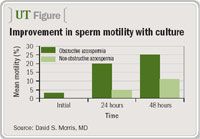Article
Do culture type, duration affect sperm motility?
Author(s):
New Orleans-While improvements in sperm motility are seen when sperm are incubated in media for extended periods, no guidelines have been established yet for the optimal duration of incubation and culture type. Investigators from the University of Michigan have addressed this issue and have made determinations that may help guide intracytoplasmic sperm injection.

"We sought to characterize improvement in motility for sperm isolated by testicular aspiration by incubation in different media over time. We found that incubation in processing medium (PM) or Ham's F-10 medium improved sperm motility, with significant improvement noted between 24 and 48 hours," reported David S. Morris, MD, a urology resident at the University of Michigan, Ann Arbor, working with Dana Ohl, MD, and colleagues.
The researchers' prospective side-by-side comparative laboratory analysis was reported at the American Society for Reproductive Medicine annual meeting here.

The numbers of non-motile and motile sperm per 20 high-powered fields were assessed at initial collection and after 24 or 48 hours of incubation in either PM (Irvine Scientific, Santa Ana, CA) or Ham's F-10 + albumin (F-10, Irvine Scientific). Using the number of motile sperm and the total number of sperm, motility was calculated as a percentage. A mixed regression model controlling for side, medium, and baseline motility was created to analyze the change in motility between 24 and 48 hours.
Sperm motility significantly improved after culture with either medium. Initial motility in the obstructive patients was 3%, increasing to 20% at 24 hours and 25% at 48 hours. Initial motility in the non-obstructive patients was 0%, increasing to 5% and 11%, respectively.
"Patients with obstructive azoospermia showed a steady increase with culture using both PM and F-10 media. The non-obstructive patients also had an increase with culture using either medium, but the motility reached was lower," Dr. Morris said.
Markedly increased motility
In an assessment of motility change from 24 to 48 hours, investigators observed that nearly twice the number of samples increased in motility as decreased (47% vs. 28%) or remained stable (25%).
"In other words, 75% of the samples either remained stable or improved with continued culture to 48 hours," he noted.
In a comparison of the media types, 54% of the samples in F-10 medium increased in motility from 24 to 48 hours, compared to 41% with the PM medium (p=.03). In a comparison between the two groups, obstructive patients were more likely to have an increase in motility from 24 to 48 hours (54%) compared to non-obstructive patients (33%), which was highly significant (p=.0008).
When patients with spinal cord injury or radical retroperitoneal lymph node dissection were examined separately, they were significantly less likely to achieve an increase in motility from 24 to 48 hours compared with obstructive and non-obstructive patients. Only 33% increased, while 39% decreased in the interval between 24 and 48 hours, Dr. Morris reported.















